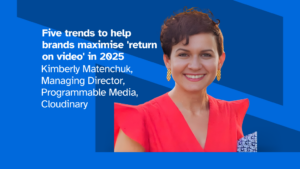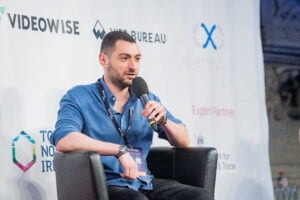By Damian Collier, CEO, Blend Media
The immersive content market may have started out slowly but it is gaining momentum fast. From the recent introduction of Augmented Reality (AR) ads to Facebook’s Newsfeed, to the latest generation of low cost, high quality Virtual Reality (VR) headsets, technology maturity is introducing new immersive opportunities for brands and agencies. Yet despite the wealth of talent globally, the biggest hurdle to market development remains a lack of knowledge, confidence and easy access to skilled creators.
But demand is growing; brands and agencies need to be in the immersive game. So how can companies gain fast access not only to a deep pool of trusted creative talent but also better manage the entire immersive process, from collaboration to delivery?
Immersive ROI
The Global AR and VR market is estimated to reach $571.42 billion by 2025 and Gartner estimates that 100 million people will be shopping in AR by 2020. But for brands and agencies looking to capitalise on the growing trends, this is still a new market — and one that can be difficult to navigate.
There is no clear return on investment model just yet. No consensus on what works and what doesn’t. And while this is a fast maturing market, few organisations have the desire or ability to build and maintain the in-house expertise required to keep up with the technology advancements and the multitude of available content formats and platforms.
With no standard pricing model, many brands and agencies have no idea whether an AR filter for Instagram should cost £50,000 or £5,000; whether a location-based VR experience should cost £100,000 or £1,000,000. The challenge is not simply access to trusted talent. It is cost effectively managing complex, multi-tiered developments that deliver value.
Even if skilled existing creators have been identified, are they right for this particular project? Do they have the right experience? Are they available within the timeframe? Briefing several different creators individually can be a slow process. Even harder to then coordinate these people throughout a project to hit a deadline. Add in the management of Non-Disclosure Agreements (NDA), Master Service Agreements and payment processes and many brands admit to being deterred from venturing into the immersive space.
Immersive Demand
If the market is to move forward, it requires consistency in product delivery and confidence in the quality of creative talent available. It requires a model that enables organisations to develop immersive content in a trusted and timely way, cost-effectively, with minimal risk. And, to be honest, with the huge ongoing investment in immersive from big tech names like Facebook, Apple and Google, can brands afford to avoid it any longer?
This is a market that is maturing and ready to go. Cheaper, better quality headsets are driving adoption. 360 video and AR have been introduced by social media giants Facebook, Snapchat and Instagram and features such as face filters are now commonplace.
Furthermore, market development investment is huge – from Apple’s and Facebook’s upcoming AR glasses to Google’s visual search and Facebook’s Horizon interconnected social VR world where people can explore new places, play games and build communities. This is a market that every brand and agency needs to explore, understand and embrace.
The good news for brands and agencies entering the immersive world is that there is a wealth of creative talent available. The problem is that, to date, this talent pool has been completely fragmented, making it incredibly difficult to locate creatives not only with the right technical skillsets but also relevant industry experience.
Now this wealth of global immersive talent is coming together on a single marketplace, providing not only immediate access for brands and agencies but also enabling essential collaboration between individuals.
Immersive Marketplace
Today, over 700 trusted creators are accessible through the marketplace, providing brands with immediate access to the relevant skills and experience. But this marketplace is about more than matching brands to talent – it is about removing the friction points along the way from initial brief through negotiation, hiring and project completion.
A brand or agency can upload an immersive brief, where relevant creators surfaced by the platform’s proprietary algorithms will then have the chance to bid for projects. In addition to shifting the burden of managing the bid process, this also builds competition and creates a structured market and a more mature and consistent pricing model.
Brands can review recommendations, as well as look at creators’ portfolios. Secure messaging enables potential collaborators to discuss the project and ask questions before pitching, as well as throughout the creative process. Work in progress can be shared, with comments, to aid collaboration and keep the project on track and to deadlines. NDAs, MSAs and Statements of Work can be managed easily.
And for creators, the marketplace’s secure escrow account also guarantees payment at completion, reducing both risk and the admin headache of chasing clients. Looking ahead, the marketplace will add client ratings to each creator’s portfolio, building trust by adding essential feedback to the skills and experience information; as well as adding an information centre that will allow creators to share knowledge and experience.
Conclusion
The speed with which AR and VR content is evolving is compelling. Brands and agencies concerned about the lack of VR headsets in the home, for example, when compared to phones and TVs, are creating 360 video campaigns that reach audiences across the social media spectrums as well as location-based VR experiences. AR filters and experiences are becoming increasingly popular.
Whether a brand or agency has already dabbled with AR and VR content or is just getting started, fast access to a single source of all things immersive is invaluable. This is not just about finding talent; it is about building a successful immersive strategy, leveraging creative collaboration from individuals with skills and experiences globally. Some projects can be short and sweet — the AR filter for Instagram for example.
Others will be far more complex, starting off with a creative technologist who can build the structure for the project, define whether it should be in AR or VR, for example, and then moving on through finding the people to design and build it, and enabling those creators to work together.
With a single platform that enables organisations to manage the entire immersive process, from initial access to creative talent through collaborative development and through to delivery, the entire process is simplified, the time, cost and risk reduced. What was, for some, a daunting market and a potentially laborious process has become achievable — brands now have the chance to make their immersive content dreams a reality.









